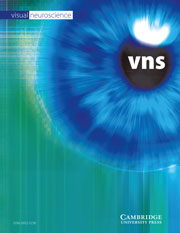Article contents
Specificity of brain reactions to second-order visual stimuli
Published online by Cambridge University Press: 19 May 2015
Abstract
The second-order visual mechanisms perform the operation of integrating thespatially distributed local visual information. Their organization istraditionally considered within the framework of the filter-rectify-filtermodel. These are the second-order filters that provide the ability to detecttexture gradients. However, the question of the mechanisms' selectivity to themodulation dimension remains open. The aim of this investigation is to answerthe above question by using visual evoked potentials (VEPs). Stimuli weretextures consisting of staggered Gabor patches. The base texture wasnonmodulated (NM). Three other textures represented the base texture which wassinusoidally modulated in different dimensions: contrast, orientation, orspatial frequency. EEG was recorded with 20 electrodes. VEPs of 500 ms durationwere obtained for each of the four textures. After that, VEP to the NM texturewas subtracted from VEP to each modulated texture. As a result, three differentwaves (d-waves) were obtained for each electrode site. Each d-wave was thenaveraged across all the 48 observers. The revealed d-waves have a latency ofabout 200 ms and, in our opinion, reflect the second-order filters reactivationthrough the feedback connection. The d-waves for different modulation dimensionswere compared with each other in time, amplitude, topography, and localizationof the sources of activity that causes the d-wave (with sLORETA). We proceededfrom the assumption that the d-wave (its first component) represents functioningof the second-order visual mechanisms and activity changes at the followingprocessing stages. It was found that the d-waves for different modulationdimensions significantly differ in all parameters. The obtained results indicatethat the spatial modulations of different texture parameters caused specificchanges in the brain activity, which could be evidence supporting thespecificity of the second-order visual mechanisms to modulation dimension.
Information
- Type
- Research Article
- Information
- Copyright
- Copyright © Cambridge University Press 2015
References
- 6
- Cited by

